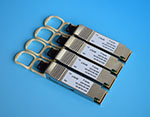标准光模块

2x100G-QDD-100
Description
Product Description
2x100G-QDD-100 is Multi-Vendor MSA Compatible 2x100GBASE-SR4 QSFP28-DD (Quad Small Form-Factor Pluggable Double Density) Transceiver designed for operation over multi-mode optical fiber. 2x100G SR4 has a QSFP-DD form factor which supports eight electrical interface lanes which can operate in 25G NRZ encoding mode resulting in 200G (8x25G) data rate. Technically 2x100GBASE-SR4 QSFP28-DD modules consists of two 100G transceivers in one housing which can provide great flexibility for operators in their migration path towards QSFP-DD gear and 400G PAM4 infrastructure and help to make necessary interconnections with high density legacy 100GBASE-SR4 QSFP28 interfaces which use NRZ encoding. Module has a minimum guaranteed optical budget of 1.9 dB, which in most cases is enough to reach 100 m over OM4 multimode fiber, or 70 m over OM3 multimode fiber. However, distance is just an indicative parameter calculated for comfort of identification. Eventually we calculate distance taking in account minimal optical budget and average attenuation of optical cabling in industry. 2x100G SR4 uses 8 channel 25Gb/s VCSEL (Vertical Cavity Surface Emitting Laser) (850 nm) transmitters and 8 channel 25Gb/s PIN photodiode receivers. Module supports DDM/DOM optical diagnostics, which provide diagnostic information about the present operating conditions. 2x100G-QDD-100 operates in standard 0°-70°C temperature range and has an MPO/MTP-24 connector. 2x100GBASE-SR4 QSFP-DD supports 2×103.125 Gbps data rate and such applications as 2x100G Ethernet (206.25 Gbps). 2x100G-QDD-100 optical transceiver is a multi-purpose module which can be used in various scenarios in today’s networking environment. Most popular applications are Telecom Metro/Core, Mobile Operator Core or Data Center Core Networks.
| Media Type: |
Multi-Mode Fiber (MMF) |
|---|---|
| Connectors: |
MTP/MPO-24 |
| Supported Data Rate: |
2×103.125 Gbps |
| Supported Applications: |
2x100G Ethernet (206.25 Gbps) |
| Modulation |
NRZ (Non-return-to-zero) |
| DDM/DOM: |
Supported |
| CDR (Clock and Data Recovery) chip |
Supported |
| Minimum Optical Budget: |
1.9 dB |
| Maximum Distance: |
100 m (OM4) / 70 m (OM3) |
| TX Wavelength: |
8×850 nm |
| Tx Wavelength Bandwidth: |
20 nm (840-860 nm) |
| Transmitter Type: |
VSCEL Laser |
| RX Wavelenght: |
8×850 nm |
| Rx Wavelength Bandwidth: |
20 nm (840-860 nm) |
| Receiver Type: |
PIN photodiode |
| Average Launch Power (Min) Each Lane: |
-8.4 dBm |
| Average Launch Power (Max) Each Lane: |
2.4 dBm |
| Extinction Ratio (Min): |
3 dB |
| Average Receiver Sensitivity (Min) Each Lane: |
-10.3 dBm |
| Average Receiver Sensitivity (Max) Each Lane: |
2.4 dBm |
| Receiver Overload: |
3.4 dBm |
| Temperature Range: |
Standard 0°-70°C |
| Storage Temperature: |
-20° to 85°C |
| Relative Humidity: |
0 to 85% |
| Power Consumption: |
≤4W |
| Power: |
+3.3V |
| Compliance: |
CMIS V4.0, IEEE 802.3bm 100GBASE-SR4, QSFP-DD MSA, RoHS-6, CE, SFF-8665 |
Important Notice
Performance figures, data and any illustrative material provided in this data sheet are typical and must be specifically confirmed in writing by F-tone Networks before they become applicable to any particular order or contract. In accordance with the F-tone Networks policy of continuous improvement specifications may change without notice.
The publication of information in this data sheet does not imply freedom from patent or other protective rights of F-tone Networks or others. Further details are available from any F-tone Networks sales representative.


